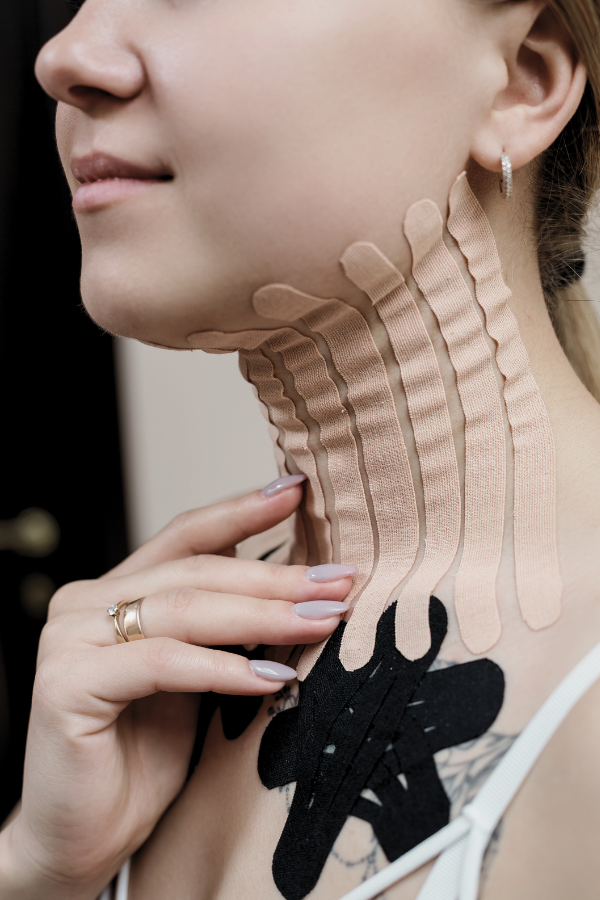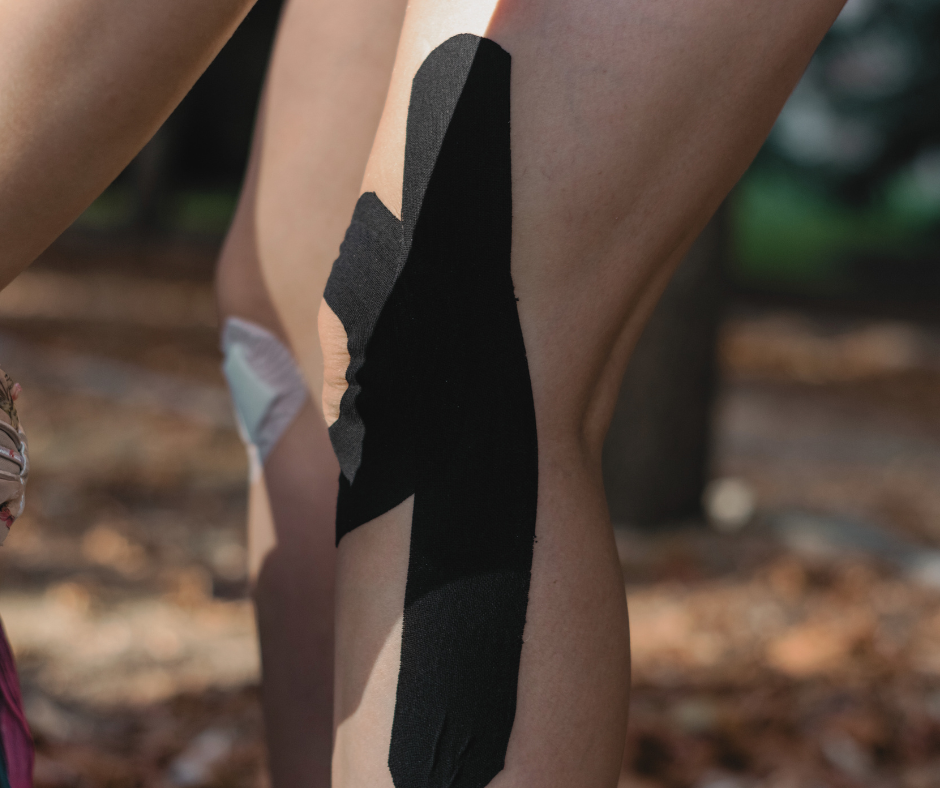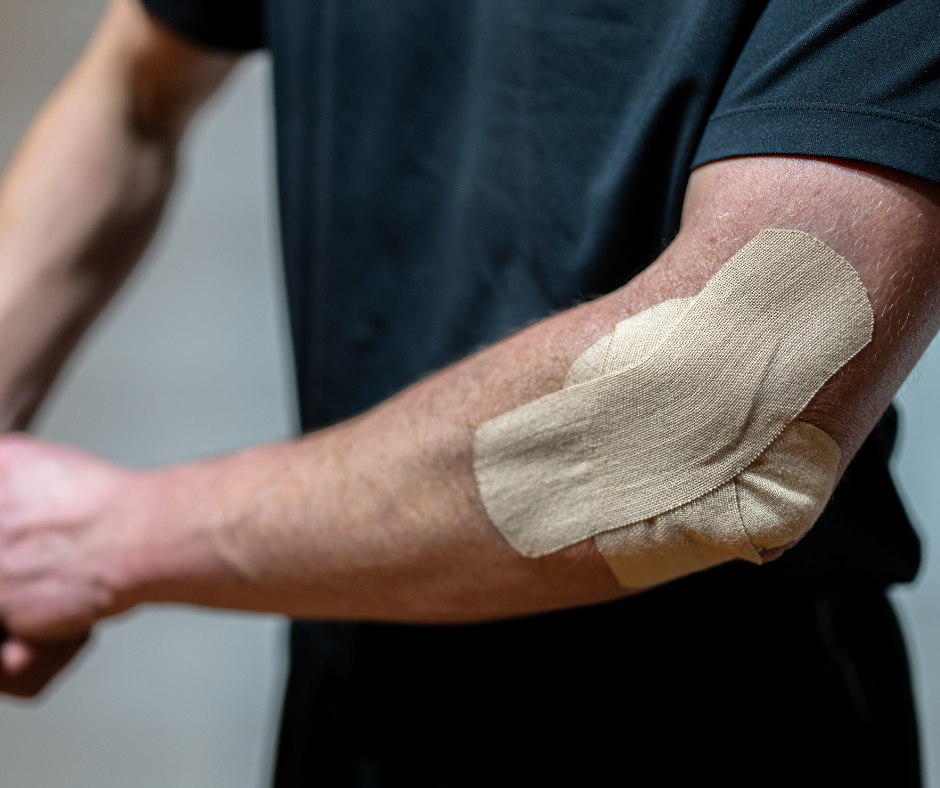

Pain Management, Mobility, and Minimized Injury Risk: What is Kinesio Taping?
Summary
Reflection Questions
Journal Prompt
Kinesiotaping, a therapeutic technique developed in the 1970s, has gained widespread recognition in sports, physical therapy, and other forms of rehabilitation. Characterized by its distinctive elastic tape applied to the skin, Kinesio taping is designed to provide support and stability to muscles and joints while maintaining a full range of motion. Its rise to prominence in athletic circles, notably observed in high-profile sporting events, has highlighted its utility in enhancing performance, aiding injury prevention, and facilitating quicker recovery. In the therapeutic context, kinesio taping is lauded for its role in pain management, reducing inflammation, and improving neuromuscular function, making it a versatile tool in both clinical and sports settings. Let’s delve into the science behind kinesiology tape and explore common applications like pain reduction, enhanced mobility, and minimized injury risk. Read on to learn more. Read on to learn more.
History and Development of Kinesio Tape
Kinesio Tape was developed in the 1970s by Dr. Kenzo Kase, a Japanese chiropractor and acupuncturist. Dr. Kase sought a taping method that could support joints and muscles without the rigidity associated with traditional athletic tape.
He aimed to create a tape that would provide support but not restrict the range of motion, allowing for better movement and healing. The unique elastic properties of Kinesio Tape were designed to mimic the elasticity of human skin, thus offering support while enabling movement, unlike conventional elastic therapeutic tape that immobilized the applied area.
The Evolution of Its Use Over the Years


Over the years, Kinesio Tape’s use has evolved significantly. Initially used by sumo wrestlers and other athletes in Japan, it gained international attention in the 1980s and 1990s as more athletes began to use it. The tape’s visibility in major sporting events, especially the Olympics, further increased its popularity.
Its uses expanded beyond sports into rehabilitation and physical therapy, where it’s used for a variety of conditions, from reducing inflammation and swelling to correcting postural issues and managing chronic pain. Today, Kinesio Tape is widely recognized as a versatile tool not only in sports medicine but also in the treatment of a broad spectrum of musculoskeletal and neuromuscular conditions.
What is Kinesio Tape?
Kinesio Tape is distinct in its design and functionality. It is thin and highly elastic, designed to mimic the thickness and elasticity of human skin. This quality allows for a full range of motion when applied, a stark contrast to traditional athletic tapes that are typically more rigid.
Kinesio Tape is also characterized by its wave-like adhesive pattern on one side, which facilitates air circulation and moisture release, reducing the risk of skin irritation and discomfort. The tape’s elasticity is not only uniform but also allows it to stretch up to 120-140% of its original length, which is key to its therapeutic effects.
Materials Used in Its Manufacture
The primary material used in the manufacture of Kinesio Tape is a cotton fabric, which is chosen for its breathability and durability. This cotton fabric is combined with a heat-activated acrylic adhesive, which is hypoallergenic and gentle on the skin.
The combination of these materials ensures the tape is water-resistant and can remain in place for several days, even through sweating and showering. Unlike some traditional athletic tapes, Kinesio Tape does not contain latex or other potentially irritating substances, making it suitable for long-term wear and use by individuals with sensitive skin.
The Science Behind Kinesio Tape
Kinesio Tape is believed to work by lifting the skin slightly away from the underlying tissues. This lifting effect is thought to create a small space between the skin and the muscles or fascia beneath it. This space is believed to reduce compression on the lymphatic drainage channels, enhance blood circulation, and decrease inflammation in the taped area.
Additionally, Kinesio Tape is proposed to stimulate sensory feedback to the brain, which can help in reducing pain and improving proprioception (the body’s ability to sense its position and movement). By supporting and stabilizing muscles and joints while still allowing for a full range of motion, Kinesio Tape is seen as facilitating the body’s natural healing process while also aiding in injury prevention and management.
Theories Behind Its Effectiveness
The effectiveness of Kinesio Tape is underpinned by several theories. The most prominent is the theory of fascial unloading, where the tape’s elasticity helps to lift the skin and reduce pressure on pain receptors under the skin.
This mechanism is proposed to alleviate discomfort and improve mobility. Another theory relates to its impact on the neuromuscular system: by providing sensory stimulation to the skin, Kinesio Tape is thought to enhance proprioceptive feedback, which can help in retraining muscles and nerves in injured areas.
Theories also suggest that the tape’s presence on the skin can modulate pain pathways, providing relief from chronic pain conditions. While research continues to explore the full extent of Kinesio Tape’s effectiveness, these theories form the basis of its widespread use in physical therapy and sports medicine.
Mechanisms of Action


Kinesiotaping exerts its effects on muscles and joints primarily through mechanical and neurological pathways. Mechanically, the elastic quality of the tape provides dynamic support to the muscles and joints, helping to stabilize them without restricting movement. This support can reduce the strain on muscles and joints, potentially preventing overextension or overuse injuries.
Neurologically, the tape’s application on the skin is believed to stimulate sensory receptors, which can modify the perception of pain and improve proprioceptive feedback. This sensory stimulation can lead to improved muscle activation and coordination, enhancing joint stability and reducing the likelihood of injury or re-injury.
The Role of Kinesiotaping in Improving Circulation and Reducing Inflammation
Kinesiotaping is thought to improve circulation and reduce inflammation through its physical interaction with the skin and underlying tissues. The tape’s elasticity creates a lifting effect on the skin, which can increase the interstitial space and thereby reduce compression of blood vessels and lymphatic channels.
This decompression can enhance blood flow and lymphatic drainage, facilitating the removal of waste products and inflammatory mediators from the affected area. Improved circulation also means increased delivery of oxygen and nutrients, which can aid in the healing process. The reduction in inflammation and improvement in circulation can help alleviate pain and accelerate recovery from muscle and joint injuries.
Common Uses of Kinesiology Taping
Muscle Sprains and Strains
Kinesiology taping is frequently used for managing muscle sprains and strains. By providing support and stability to the affected muscles, the tape helps reduce strain and stress on injured tissues. Its elastic property allows for a degree of movement, crucial for maintaining muscle strength and flexibility during the healing process.
Posture Correction
The application of kinesiology tape can assist in correcting postural imbalances. The tape provides a gentle, continuous stimulus to the skin and underlying muscles, encouraging them to maintain a more anatomically aligned posture. This is particularly beneficial for individuals who experience discomfort or pain due to poor posture.
Inflammation and Swelling
Kinesiology tape is often utilized to manage inflammation and swelling, especially in sports-related injuries. The lifting effect of the tape on the skin is thought to enhance lymphatic drainage and circulation, thereby reducing swelling and accelerating recovery.
Pain Relief
Depending on the kinesio taping method, it can be used to reduce pain. The tape’s sensory stimulation on the skin is believed to interfere with pain signals sent to the brain, a concept known as the “gate control theory” of pain. This can help alleviate both acute and chronic pain in various musculoskeletal conditions. For example, this study found that “Kinesio taping can be used as a complementary treatment method to achieve effective control of pregnancy-related low back pain.”
Injury Prevention and Minimized Risk
In sports and physical activities, kinesiology tape is used proactively to prevent injuries. It supports vulnerable areas like knees, ankles, and wrists, potentially reducing the risk of injury during high-impact or repetitive activities.
Enhanced Mobility
Kinesiology taping supports joints and muscles without significantly restricting range of motion. This property makes it an excellent tool for enhancing mobility, especially in individuals recovering from injuries or with joint stiffness.
Sports Performance
Athletes use kinesiology tape to improve their sports performance. The tape can provide muscular and joint support, improve proprioceptive feedback, and potentially enhance endurance and strength during athletic activities. However, some studies have found that kinesio taping does not improve the performance of athletes without pre-existing conditions. For example, the results of this 2012 study “indicated that KT might not enhance muscle endurance in healthy athletes.”
Rehabilitation
In rehabilitation settings, kinesiology tape is a valuable adjunct to therapy. It aids in the rehabilitation process by supporting injured areas, reducing pain, and facilitating correct movement patterns, which are crucial for effective recovery and preventing re-injury.
Kinesiotape as Part of an Integrated Approach to Physical Therapy


Physical therapists use Kinesio tape as part of a comprehensive treatment plan for various musculoskeletal conditions. Kinesio tape is often one element of a broader therapeutic approach, which may include exercises, manual therapy, and other modalities. It is not a standalone treatment but is used to complement other therapeutic interventions for more effective outcomes.
A physical therapist might also apply Kinesio tape to areas of pain, such as the back, knee, or shoulder. Some believe that the tape impacts the sensory nervous system, providing a pain-relieving effect by interfering with pain signals sent to the brain. This can be particularly beneficial for patients with chronic pain conditions.
In cases of injury or post-surgical recovery, Kinesio tex tape application can be used to reduce swelling of soft tissue. The lifting effect of the tape on the skin is thought to enhance lymphatic drainage and circulation, helping to reduce inflammation and accelerate the healing process.
For patients recovering from muscle strains, ligament sprains, or joint injuries, Kinesio tape can provide support and stability without restricting the full range of motion. This can be crucial in the rehabilitation of injuries. For example, Kinesio tape is commonly used in injuries to the knee joint.
Physical therapists use Kinesio tape to correct postural imbalances and improve muscle function. The tape provides sensory feedback, which can help retrain muscles and joints to maintain a healthier posture or alignment.
In rehabilitation, particularly for athletes, Kinesio tape can be applied to facilitate certain movements or enhance performance. It can be used to improve proprioceptive feedback, which is essential for effective and safe movement patterns. Physical therapists may also use Kinesio tape as a preventive measure, especially for athletes or individuals with a history of specific musculoskeletal injuries. The tape can help support vulnerable areas and reduce the risk of future injuries.
Popular Brands of Kinesio Tape
Several brands of kinesiotape are popular among users, each with its own set of features and reviews. These tapes offer a range of features and should be selected based on individual needs, such as sensitivity, water resistance, and the specific area of application.
KT Tape Original Cotton Athletic Tape: This pre-cut kinesiology tape is made from lightweight, breathable cotton. It’s suitable for those with sensitive skin as it’s latex-free and hypoallergenic. The tape is designed to stay on for up to three days, even when exposed to sweat and water. However, some users have noted that the adhesive may not last very long and it can be painful to remove.
OK TAPE Kinesiology Tape: Known for being stretchy, soft, and budget-friendly, this tape combines cotton and spandex. It’s also latex-free and hypoallergenic, making it a suitable choice for those with sensitive skin. The tape is water-resistant for up to three days and comes in precut strips, available in various colors.
Hampton Adams Kinesiology Tape for Physical Therapy Sports Athletes: This latex-free and hypoallergenic tape can last up to ten days and is designed to outlast sweat and water. It’s available in multiple colors but comes in a continuous roll, which may be less convenient for some users.
TheraBand Kinesiology Tape: Ideal for beginners, this tape comes in precut strips with XactStretch indicators to guide proper application. The tape, made from a blend of cotton and spandex, is latex-free and non-irritating, and comes in nine colors.
KT Tape Pro Synthetic Kinesiology Therapeutic Sports Tape: This tape is designed with sensitive skin in mind, made from synthetic performance fabric that is lightweight, latex-free, and hypoallergenic. It’s available in ten colors and offers a moisture-wicking feature.
RockTape H2O Edge Highly Water-Resistant Kinesiology Tape: A great choice for swimmers, this tape is made from a blend of cotton and nylon with a water-repellent coating. It’s hypoallergenic and can stay on for up to seven days. The tape comes in four colors.
Sparthos Kinesiology Tape: Made for active runners, this tape is lightweight, long-lasting, and stretchy. It’s made from soft, breathable cotton and designed to move freely with the body. The hypoallergenic adhesive can last up to five days, and it’s water-resistant.
TheraBand Kinesiology Tape: This tape is a favorite among lifters for its well-made adhesive, easy application, prolonged support, and affordability. It provides support without limiting mobility, making it ideal for powerlifters and Olympic weightlifters.
Kinesio Tex Gold Cotton Tape: Made of 100% cotton, this tape is easier on the skin and ideal for those with sensitive skin. The hypoallergenic and latex-free adhesive is suitable for use in hot and humid environments.
Nordic Lifting Kinesiology Tape: This synthetic tape is designed to perform well in water, making it suitable for swimmers. It offers support while training in aquatic environments.
FlexU Supreme Kinesiology Tape: This synthetic tape is designed for knee support, offering flexibility and a strong adhesive that remains in place for extended periods.
StrengthTape Kinesiology Tape: Ideal for CrossFit-style workouts, this tape is versatile and maintains its adhesiveness during intense training sessions.
Application Techniques


When applying Kinesio tape, several basic principles should be followed for optimal effectiveness. The skin area where the tape is to be applied must be clean, dry, and free of oils or lotions. The tape should be cut to the appropriate length and shape based on the specific muscle or joint area being targeted.
When applying the tape, it is important to apply the ends with no stretch and only stretch the middle portion, typically between 25% and 75% of the tape’s maximum stretch capability, depending on the intended purpose. The direction of the tape application should align with the natural movement of the muscle or joint. It is also crucial to rub the tape after application to activate the heat-sensitive adhesive for better adherence to the skin.
When to Self-Apply vs. Seek Professional Help
According to this resource from the Kinesio Taping Association International, “Knowing how to apply the tape is instrumental in an application’s success.” Self-application of Kinesio tape is feasible for simple, accessible areas of the body and for minor issues.
However, for more complex musculoskeletal conditions, or when taping hard-to-reach areas like the back or shoulders, it is advisable to seek professional help. Healthcare professionals such as physical therapists or certified Kinesio taping practitioners can assess the individual’s specific needs and apply the tape with the correct tension and pattern for the condition being treated.
Additionally, they can provide guidance on how to safely and effectively apply the tape at home for ongoing treatment. Seeking professional advice is especially important for individuals with skin sensitivities or underlying health conditions.
Potential Limitations and Risks
Misconceptions and Potential Risks Associated with Kinesiotaping
Kinesiotaping, while beneficial for many, does come with potential risks and misconceptions. One common misconception is that the tape can provide the same level of support as medical braces or traditional athletic taping, which is not the case. Kinesio tape is designed for minor support and proprioceptive feedback, not for significant structural support.
Many tape users do not thoroughly research appropriate techniques before applying the tape to their skin. As the authors of this 2020 study note, “The insufficiency of fundamental knowledge about the appropriate usage of kinesiology tapes can generate undesired side-effects caused by incorrect application of kinesiology tapes and/or denouncement of kinesiology tapes as an ineffective practice.”
Risks involved include skin irritation or allergic reactions, particularly for those with sensitive skin. Over-reliance on the tape for injury treatment without addressing underlying issues through physical therapy or medical consultation can also be a concern. It’s important for users to understand that kinesiotaping is an adjunct therapy, not a primary treatment modality.
Situations Where Kinesiotaping May Not be Advised
Kinesiotaping may not be suitable in certain situations. It is generally not advised on areas of the skin that are wounded, bruised, or have rashes, as it can exacerbate these conditions. Individuals with dermatological conditions like eczema or psoriasis should also be cautious.
Kinesiotaping is not recommended for individuals with severe allergies to adhesives. In cases of deep vein thrombosis or other serious vascular conditions, kinesiotaping might pose risks and should be avoided. Additionally, it should not be seen as a substitute for more comprehensive medical treatment in severe musculoskeletal injuries.
In all cases, consulting with a healthcare professional before using kinesio tape is strongly recommended.
Final Thoughts on Using K Tape


Kinesiotaping is commonly used as a complement to other modalities in sports medicine and physical therapy, offering benefits like pain relief, enhanced mobility, and support for muscles and joints without compromising range of motion. Despite its widespread use, it’s important to recognize its limitations and understand that it’s not a substitute for comprehensive medical treatment.
The technique requires correct application, and in certain cases, professional guidance is advisable. As research continues, the future of kinesiotaping looks promising with ongoing studies exploring its full potential and efficacy. This may lead to a deeper understanding of its mechanisms and possibly broader applications in therapeutic practices. The evolving nature of this field underscores the importance of staying informed about the latest findings and recommendations in kinesiotaping.








